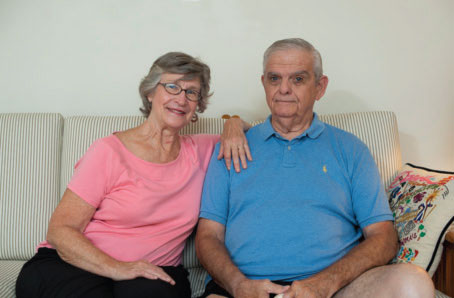“My wife and I finally decided that if I was going to have the quality of life that I wanted, then I needed to have knee surgery,”

Frederick Yorke III is a beachcomber at heart. In his youth, he would spend summer days with his family on the beach at Seaside Park, learning such maritime pastimes as crabbing and boating. As an adult, the longtime Ocean County resident has spent many an afternoon fishing off the Jersey shore.
But in recent years, progressive osteoarthritis has made it difficult for Fred to enjoy life at sea or on dry land. He started feeling pain in his knees and upper body while in his 60s, and the pain started intensifying five years ago.
As the pain increased, so did the limits on Fred’s life. He had trouble walking any distance, and he could only visit handicapped-accessible places. “My biggest problem was stairs,” says Fred, now age 76.
“I really couldn’t function with stairs any longer. It got to the point where my wife, Janet, and I stopped visiting some friends and relatives because I couldn’t get up their stairs.”
Treatments Tried & Failed
Fred tried different treatments, from physical therapy to hyaluronic acid injections, but the knees kept getting worse. “My wife and I finally decided that if I was going to have the quality of life that I wanted, then I needed to have knee surgery,” Fred says. “No other treatment was going to help much.” Fred’s primary care physician referred him to Mark Kasper, MD, an orthopedic surgeon with The Total Joint Replacement and Spine Institute at Community Medical Center (CMC). The Institute has The Joint Commission Gold Seal of Approval for hip and knee replacement, so Fred knew he would be in good hands.
On August 2, Dr. Kasper performed a total replacement of Fred’s right knee using the Mako Robotic Arm-Assisted System. Mako uses computer tomography to create a 3-D model of the patient’s bone anatomy. The surgeon uses that model to tailor surgery to the patient’s unique anatomy, helping to protect soft tissue around the knee. The surgeon guides the robotic arm to remove diseased bone and cartilage, then to insert and adjust the joint replacement.
Robotic Surgery Benefits
Compared with traditional joint replacement surgery, robotic surgery allows the surgeon to make a smaller incision with more precise cuts to the surrounding tendons and tissue. Dr. Kasper notes that this reduces tissue and muscle injury during surgery and can promote more efficient healing.
While robotic surgery doesn’t significantly shorten overall recovery time compared with traditional knee replacement surgery, Dr. Kasper notes that in practice he has seen patients progress more quickly during the first two months of recovery after robotic surgery.
The precision that comes with roboticassisted surgery may give total knee eplacement a more natural feel over time,says Dr. Kasper. Citing clinical studies, he notes that while patients overall are satisfied with their knee replacements, approximately 20 percent still sense that they’re walking on an implanted knee years after surgery. By contrast, he says, “Patients who undergo total hip replacement hardly feel that they had a hip replacement. We’re trying to create the same kind of experience for total knee replacement patients.”
The Road To Recovery
Most patients who undergo total knee replacement through the Total Joint Replacement and Spine Institute return to full activities six months to one year after surgery, says Dr. Kasper. Along the way, patients follow a general timeline to recovery that begins one to four weeks before surgery with a pre-operative class at the institute. Patients scheduled for total or partial joint replacement surgery are strongly encouraged to attend the class, during which the orthopedic nursing staff explains what will happen during the procedure and what to expect during recovery.
After surgery, Dr. Kasper notes, most joint replacement patients stand with minimal assistance the same day, and are discharged after one to two nights in the hospital.
As for Fred Yorke? Before he can set sail again, he must undergo total left knee replacement once he has fully recovered from the right knee procedure. But for now, Dr. Kasper is pleased with Fred’s progress.
“He’s going faster than the average,” says Dr. Kasper. “He’s two or three weeks ahead of schedule. He’s very determined to recover.”